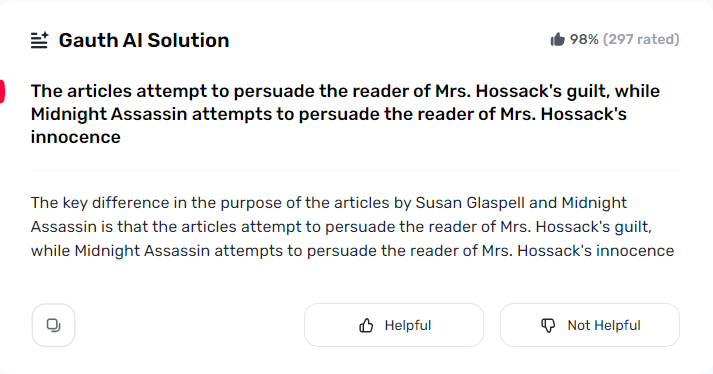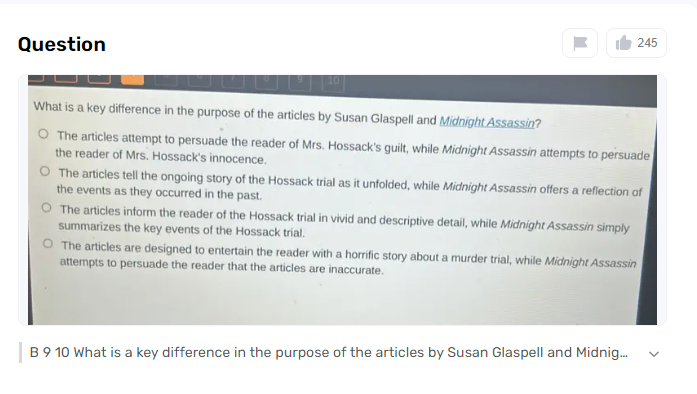Both the book Midnight Assassin and Susan Glaspell and the articles she wrote represent distinct approaches to journalism and storytelling, each driven by distinct goals that are reflective of their respective historical contexts and narrative styles. Susan Glaspell, a spearheading writer and dramatist, composed articles for the Des Moines Everyday News in the mid-1900s, zeroing in on the homicide instance of John Hossack.
Glaspell’s editorial style focused on instantaneousness and public commitment, offering a continuous story of unfurling occasions and legal procedures encompassing the case. This article explores what is a key difference in the purpose of the articles by susan glaspell and midnight assassin? The same Hossack murder case is examined from a contemporary historical perspective in Bryan and Thomas Wolf.
Articles By Susan Glaspell
Context
Susan Glaspell composed articles for the Des Moines Everyday News in the mid-1900s, during a period of fast industrialization and social change in the US. She expounded a ton on the homicide of John Hossack, which occurred in provincial Iowa, where cultural standards and judicial procedures were profoundly associated with rural life and local area elements.
Purpose of Articles
The main role of Susan Glaspell’s articles was to illuminate and draw in people in general with ideal updates and verifiable writing about the Hossack murder case. As a columnist, Glaspell planned to furnish her perusers with exact data about the wrongdoing, examination, and judicial procedures as they unfurled.
Techniques Used
Glaspell effectively conveyed her reporting through a variety of journalistic methods. She utilized enlightening language to strikingly depict scenes and characters, carrying perusers nearer to the occasions she portrayed. Her articles frequently highlighted interviews with key figures associated with the case.
Articles By Midnight Assassin
These are the articles by Midnight Assassin:
Genre and Scope
Patricia L.’s Midnight Assassin Bryan and Thomas Wolf fall soundly inside the class of verifiable genuine wrongdoing writing. It examines the case of John Hossack’s murder in Iowa in 1900 with great care. The book goes past a simple retelling of occasions; it arranges the homicide inside its verifiable and social setting, looking at issues like orientation jobs, equity, and the developing overall set of laws of the time.
Purpose of the Book
The primary objective of Midnight Assassin is to offer a comprehensive historical analysis of the Hossack slaying and its ramifications. The book written by Bryan and Wolf seeks to decipher the case’s deeper truths and complexities, in contrast to contemporary journalism, which places an emphasis on immediate updates and public interest.
Techniques Used
In Midnight Assassin, Bryan and Wolf reconstruct the events surrounding the Hossack murder case using a combination of investigative journalism and historical research. They fastidiously filter through chronicled records, court reports, and contemporary records to sort out a cognizant story that goes past superficial subtleties.
Key Differences in Purpose
Here are the key differences:
Content Focus
Susan Glaspell wrote articles for the Des Moines Daily News in the early 1900s that primarily focused on providing current and accurate information about the John Hossack murder case. Glaspell’s articles are meant to draw in a contemporary crowd keen on shocking news and official procedures.
Audience
Susan Glaspell’s articles in the Des Moines Day-to-day News were focused on an overall crowd hungry for guaranteed news refreshes and judicial procedures connected with the Hossack murder case. Her writing appealed to readers looking for compelling narratives and factual information that reflected the concerns and interests of the time.
Evidence and Analysis
Susan Glaspell’s articles depended vigorously on firsthand announcing, court perceptions, and meetings with key figures engaged with the Hossack murder case. Her immediate testimony emphasized factual updates and descriptions of ongoing legal proceedings.
Steps To Use Gauth For Math Questions
Here are the steps to use Gauth for math questions:

Step 1: Go To Gauth
Visit the Gauth website with your preferred web browser to get started using it for math questions. Guarantee you have a steady web association for consistent access. Gauth gives an easy-to-use interface intended to help with various numerical questions, from fundamental math to complex math issues.
Step 2: Enter the Question
Once on the Gauth site, input your numerical statement into the given field. Be clear and explicit while composing your inquiry to guarantee precise outcomes. Gauth upholds many numerical articulations, conditions, and recipes. Before moving on to the next step, double-check your input for any errors.
Step 3: Get Answer
Gauth will use its advanced algorithms to process your math question once your free trial has been activated. To provide a precise response, the platform will examine the mathematical expression or equation. Processing times may vary depending on the complexity of your question.
Final Wording
The vital distinction in the motivation behind Susan Glaspell’s articles and ’12 PM Professional Killer’ lies in their methodology and expectations. Glaspell’s articles, composed for the Des Moines Everyday News, filled the quick editorial need of announcing realities and illuminating people. Patricia Bryan and Thomas Wolf’s “Midnight Assassin,” aims to provide a comprehensive and analytical account of the Hossack case.
